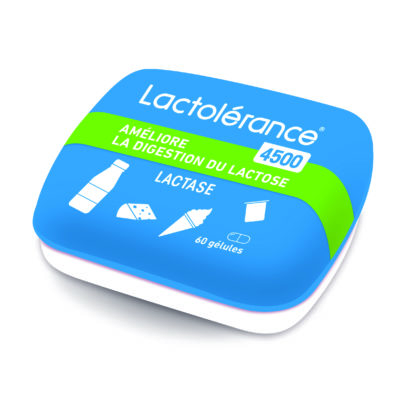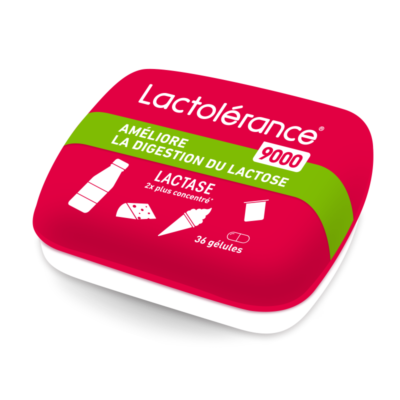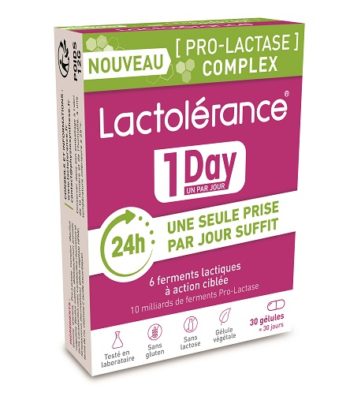
#1 What is lactose and lactase?
The lactose is the sugar (or carbohydrate) in milk - regardless of the type of milk (cow's milk, sheep's milk, goat's milk, infant milk or even breast milk) and its presentation (whole, pasteurised, semi-skimmed or skimmed milk, powdered milk or condensed milk). It is a complex sugar (disaccharide), which is only digestible if it is transformed into simple sugars (glucose + galactose).
This transformation (by hydrolysis) is normally carried out by thelactase enzyme produced in the small intestine, thereby making lactose assimilated by the digestive tract.
The lactase is therefore a digestive enzyme, present in mammals and certain bacteria, whose function is to dissociate lactose (by catalysis) in order to make it easily assimilable during digestion.
It should be noted that glucose is itself broken down into lactic acid, which will facilitate the assimilation of calcium and phosphorus by the body.
#2 What is lactose intolerance?
This is a lactase deficiency, which results in the inability to digest lactose. As a result of this deficiency, the body no longer produces enough or any lactase, the digestive enzyme that breaks down lactose into simple sugars.
In people with lactose intolerance, the unbroken lactose will ferment in the digestive tract and cause discomfort and inconvenience due to poor digestion.

Lactose intolerance can cause discomfort such as stomach ache
#3 Where does lactose intolerance come from?
In our prehistoric ancestors, as in mammals in general, the body normally stopped producing lactase after weaning. Thus, no one was lactose tolerant as an adult and thelactose intolerance was therefore the norm!
10,000 years ago, with the domestication of cattle, the Caucasian populations became accustomed to consuming milk, and their organism adapted to these new eating habits by continuing to produce the enzyme lactase in adulthood. These individuals, a minority in the world population, thus became "lactose tolerant".
Nowadays, the prevalence rate of lactose intolerance is estimated at 70% in the world population (50-80% in South America, 60-80% in Black Africa and 95% in Asia). Lactose intolerance is therefore "normal" worldwide, but a minority in Europe, where, taking all degrees of intolerance together, lactose intolerants represent about 40% of the population.

It is estimated that 5 million people in France are affected by lactose intolerance in their daily lives.
What is the difference between lactose intolerance and milk allergy?
Lactose intolerance (failure to assimilate lactose due to a deficiency of the enzyme lactase) should not be confused with l'cow's milk allergyThis requires a strong immune system response, as if in response to an attack.
The symptoms of milk protein allergy are generally more severe than those due to intolerance, can be digestive, respiratory (asthma), cutaneous, or more general: urticaria, eczema, swelling of the mucous membranes, even oedemas, diarrhoea with sometimes the presence of blood in the stools, more exceptionally anaphylactic shock.
Lactose intolerance must also be distinguished other diseases of the digestive system such as irritable bowel syndrome or irritable bowel syndrome, Crohn's disease and other food allergies (gluten allergy) or food intolerances (gluten intolerance), but also autoimmune diseases linked to the disruption of the intestinal flora - but also, of course, to transient bacterial diseases such as gastroenteritis
#3 What are the symptoms of lactose intolerance?
A lactose-intolerant person who consumes even low-lactose dairy products will only be able to digest them partially, if at all. It is this incomplete digestion that leads to fermentation in the digestive tract, and causes symptomsdigestive problems of all kinds that start with the " tummy ache "These include: borborygma (stomach rumbling), abdominal bloating, stomach ache (heartburnabdominal cramps), bloating and flatulence, diarrhoea - sometimes also: nausea and vomiting, even gastro-oesophageal reflux and gastric acidity, constipation, chronic fatigue and migraines, even hyperactivity.

Bloating, flatulence, diarrhoea... the symptoms of lactose intolerance are numerous.
These 'gastro symptoms' and digestive problems usually occur between 15 minutes and 4 hours after drinking a milk drink (a glass of fresh milk, but even a small amount of chocolate milk is sufficient) or eating products containing lactose (fresh cheeses, industrial yoghurts - while the homemade yoghurt does not contain it - but also cold cuts, ice cream, and even some medicines that use lactose as an excipient!)
#4 How to test and diagnose lactose intolerance?
There are several tests for lactose intolerance. Here are five of them:
It consists of avoid all products containing lactose for three daysIf so, you may want to take a few minutes to look at your diet and then note any improvements: have the stomach aches and digestive problems disappeared? If so, and the symptoms return once you have resumed your eating habits, then lactose intolerance is likely.
It usually takes place at the hospitalThe test is performed on an empty stomach and consists of measuring the level of hydrogen released before and after ingesting 50 grams of lactose. This test usually takes 2 hours and can be unpleasant because of the large amount of lactose ingested. The result is immediate.
With or without prescriptionIf you have a genetic predisposition to lactose intolerance, you can undergo a genetic test for primary lactose intolerance. From a blood test, you will know if you have a genetic predisposition to this intolerance. On the other hand, this test does not allow you to characterise a secondary intolerance, i.e. one caused by an illness, a medical or surgical treatment for example. The cost is relatively high: about 140 € and is not covered by social security.
Also known as measurement of blood glucose (blood test required). This consists of measuring the blood glucose level before and after the ingestion of lactose.
Take 2 capsules of lactase just before consuming a milk product; if your digestive discomfort does not appear, lactose intolerance is very likely.
In any case, you should not hesitate to talk to your doctor, dietician or gastroenterologist.
#5 How to live with lactose intolerance?
As there is no cure for lactose intolerance, which is irreversible, there are only two possible solutions to prevent the onset of symptoms: the total avoidance of lactose in the daily diet and lactase supplementation by taking a food supplement.
Total avoidance of lactose
It involves constant and unfailing daily vigilance :
- select with the utmost care products that are bought and consumed at home,
- do not preparing meals with lactose-free ingredients or products or substitutes (margarine),
- replace milk with lactose-free milk for example, or plant milk (soya milk, almond milk, rice milk, oat milk),
- ban dairy products from your shopping basket for good and certain foods such as ready meals, which may contain lactose,
- to refrain from products whose content is not precisely known (as in bakeries) and scan all ingredient labels for lactose. It is important to know that Lactose can be hidden even in sausages (where it is used as a texturizer and preservative), but also in some medicines, which use it as an excipient!

If you opt for eviction, be very careful!
On the other hand, eating out, whether in a restaurant or at a friend's house, poses a big dilemma :
- it is necessary ask the restaurant owner for confirmation the absence of lactose in its dishes and sauces,
- give guests advance notice of his food intolerance, to deprive himself of most of the food on offer: not only foods rich in lactose, but also cold meats and various preparations for the aperitif, then pizzas and sauces, cheeses. This is particularly true of fresh cheeses, as long-aged cheeses such as Gouda, Cheddar and Emmental contain only traces of lactose, as do hard cheeses such as Parmesan. Lactose has been eliminated during the curdling or coagulation phase, in the form of whey) and many desserts.
- or say nothing and fear the onset of symptoms and suffer in silence from their consequences...

Some people do not dare to talk about their intolerance and suffer in silence.
Supplementation with a lactase-based food supplement
It is based on a very simple mechanism: it provides you with the lactase that you no longer produce and allows you to assimilate lactose again. You can thus reintroduce into your diet all the products that you used to forbid yourself in order to avoid suffering from them and perhaps at the same time have a balanced diet.
This is what the product range offers you Lactolerance.
The Lactolerance range of food supplements, to avoid the symptoms of lactose intolerance
First of all, it should be noted that lactase-based food supplements have been proven effective for over 30 years in the United States, before being introduced in Northern Europe, and then in France since 2010 - with Lactolerance, which created the market there.
The lactase contained in the products Lactolerance finally makes lactose-containing foods digestible, improves the digestion of lactose and helps to eliminate the symptoms of lactose intolerance. The Lactolerance product range allows you to choose between two different formulas:

It is aimed at people who have moderate lactose intolerance. Available in a small metal pillbox, the capsules Lactolérance 4500 are to be taken on demand, immediately before the consumption of a milk product: 1 to 2 capsules are sufficient. The duration of effectiveness is 45 minutes to 1 hour.
No more gastrointestinal problems and diets, you can finally eat what you want without question!

Twice as concentrated Lactolerance 4500 is specially designed for people with severe lactose intolerance. Available in a metal pillbox or in an economy bottle, the tablets Lactolérance 9000 are also to be taken on demand, just before consuming a milk product.

It is the most innovative food supplement to permanently combat the symptoms of lactose intolerance: one capsule per day is sufficient. The lactic ferments of Lactolérance 1Day are selected in a unique alliance for their optimal lactase production. This product is aimed at people with lactose intolerance who often eat out or don't always have time to cook - or who prefer to take just one capsule a day! Lactolerance 1Day is designed for all degrees of intolerance.A clarification: Based on the principle of probiotics, lactic ferments produce lactase in the intestine, Lactolerance 1Day starts to be effective after 7 days and reaches its maximum effectiveness after 6 weeks of daily intake. During this adaptation period, it is possible to combine Lactolerance 9000 and Lactolerance 1Day.

Hello, I'm Vincent
Like you, I'm lactose intolerantI know exactly what you're going through and the difficulties you encounter on a daily basis. For over 10 years, I've been helping our customers to use our dietary supplements and giving advice and tips on how to improve their digestive comfort. I'm also a keen cook and gourmet, so you'll find my favourite recipes for a lactose-free diet in this blog.
Lactose intolerance is not inevitable! With LACTOLERANCE you can digest with complete peace of mind






